
Update: 15 May 2016.
Saw this yesterday. Fellow Copenhagener. No hands - only stumps - and with one foot pedalling his converted Nihola cargo bike. The right foot resting on a platform. The left clipped into the pedal. Still rolling strong.

Update: 08 September 2014.
Spotted this fellow citizen - on the left - ahead of me in Copenhagen today.
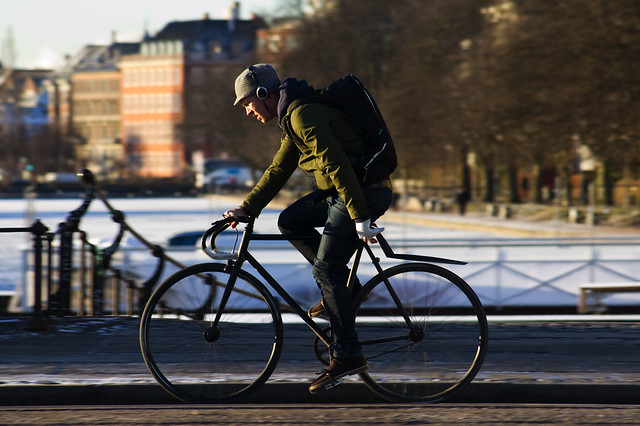
Caught this shot yesterday of a Copenhagener in the morning rush hour riding with what looks like a broken - or at least injured - hand. Still looking cool as you like.

Last weekend I spotted this Copenhagener carrying her crutches with her on her bicycle. Fair enough, she might have been heading to the hospital - across the street - to deliver the crutches back.
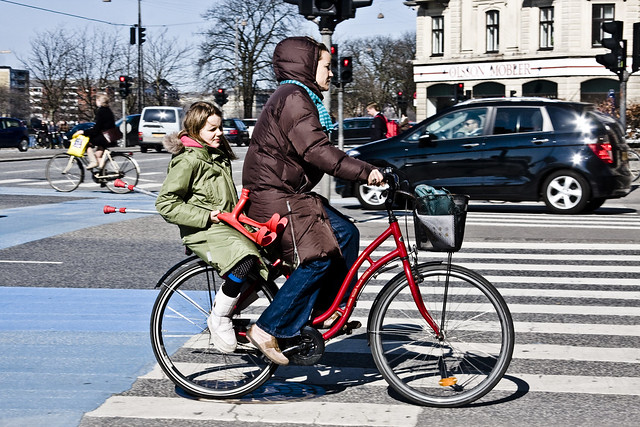
Then I remembered this shot from a while back of a girl carrying her crutches and getting doubled by her mum. The bicycle is a versatile tool. I know several friends who, after many years playing sports, have problems with their knees. They are invariably advised to ride a bicycle by their doctors.
If you also make the bicycle the quickest and safest way to get around a city, people will do so - whatever their handicap. The bicycle is a freedom machine for the people.
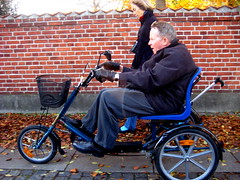
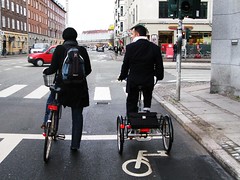
The dapper gentleman to the left may have reduced mobility for whatever reason, but he can get out and about with ease on this tricycle. Note his cane sticking out of the back.
I see the man in the right photo quite often. He rides a tricycle and only has one arm. A friend of mine knows him and I'm told that he only has one leg, too. He lost his limbs in a landmine explosion in the country he was born. He still gets about with ease on his wheels. Both of these gentlemen were impeccably dressed.
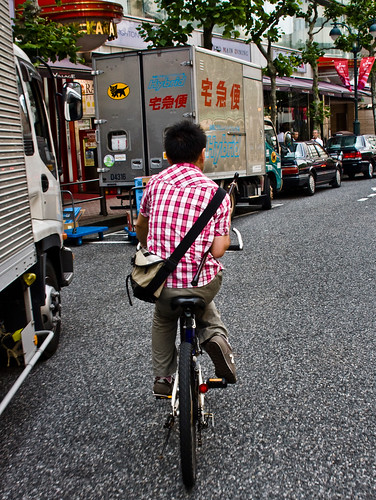
I took this photo in Tokyo. The man had some form of disability with his legs. It required effort for him to get the pedals to turn but you can bet that it was a fraction of the effort he'd use when walking.

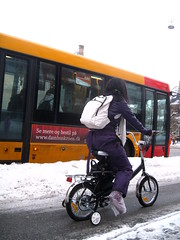
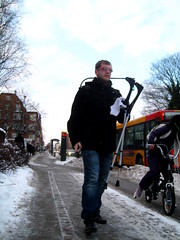
The lady on the left has a kind of cast on her leg, but still rides. The two photos on the right are from last winter. The boyfriend was holding the girls' crutches and she moved slowly along - injured foot wrapped in plastic - on a child's bicycle they had borrowed. It was icy so the crutches were probably more dangerous than helpful so the bicycle stepped in to assist. They were heading to the hospital down the road.

I spotted this lady in Vienna, Austria. Carrying her walking sticks to help her after she got off her bicycle.

This quaint sign on this tricycle reads, "Slightly Disabled".

What with all the bicycle options for disabled - whether permanently or temporarily - it's not surprising to see a parking sign like this outside my local library. It reads "Invalid Bicycles", reserving a space close to the door for those who need it.

If it is ripe old age that has reduced mobility, the bicycle still serves a purpose. I see this lady all the time in my neigbourhood. Always walking her bicycle with groceries in the basket. Perhaps too unstable to ride, but using the bicycle as a kind of crutch. Lovely.

25 comments:
Great post and thank you for sharing.
Cycling has no doubt helped me with my 'disability.' Had to stop driving as I suffer from severe dizzy spells and blackouts with complete hearing loss in my left ear and causing me to drop without warning. Cycling has been the easiest, safest (for myself and others on the road) and most reliable way for me to still get around. And for some reason, when I'm cycling, I'm able to control the attacks. Doctor has put it down to the fact my body is working whilst I'm cycling, therefore helping put any attacks on hold. Keep at it, was the advice she gave - and keep at it I will!
x
A great post!
I am 31 years old, and have been suffering from mild depression for several years. One of the first things I decided to do for myself once therapy helped me feel better, was learn how to ride a bike. It's never too late, right? It gave a sense of freedom, something you correctly refer to very often.
Surely, having been to Copenhagen last year made me admire the simplicity and beauty of your bike culture.
Thank you
Beatrice
I think the last lady didn`t want to loose her chance of going out with style!
There's a homeless guy in Porto that keeps asking money in a red light. He doesn't have one leg and in the end of the day he rides his bike fast as hell probably towards the nearest "drug supermarket".
Not cycle chic, not funny, but it shows how one can handle with the disabilities.
very good post!
I guess you might already know about this NYC Bike Messenger: http://www.dailymotion.com/video/x51ve9_fast-and-reliable_shortfilms
When I broke my ankle many years ago it was put in a below-the-knee cast, and it was actually easier for me to cycle than to walk, even with a stick, because I didn't have to use the ankle joint.
Many people thought it was kinda' weird that I could ride at all.
Also, a friend of mine has problems with her knees, and she rides a fixie so that her knee joints are constantly moving, because she's had her knees 'lock up' as she's been coasting on a freewheeled bike.
Wonderful comments! Thanks!
I am reminded of this program I heard about on the BBC many years ago in Afghanistan. http://www.one-step-beyond.de/en/countries/afghanistan/topics/afghanistan_topics_fahrradreha.html
Hi Mikael et al, ever see one of these around town? Like a built-in sheath for the crutch:
http://dccycling.blogspot.com/2010/11/staying-mobile.html
Bill
Such a touching, refreshing post. Great to see so many people getting about as they can.
I ride with an artificle left hip, and a deformed left knee. I can cycle far better than I can walk. I need to come up with a mount for my walking cane on my Mixte so I can enjoy a short walk better once I arrive to where I'm going by bike. Most people just don't understand how much cycling can help get you where you are going.
This is one of the best posts lately. It shows how the bike is useful even when one has a disabillity in ones legs. I have joint pain myself and find it hard to stand or walk for too long but I can ride a bike with no difficulty at all.
Peter
A very good post, indeed, and you make the point very well. This is the kind of thing people need to see here in North America. When someone proposes reducing car traffic somewhere, almost immediately the objections come up that it would be impossible for the elderly and the handicapped to get around any other way. People have become so used to cars as the nearly obligatory default that they have lost their ability to conceive of any other way of getting around.
Perhaps you should think about bringing things around full circle, and getting back to filmmaking. You have covered an impressive range of issues around bike transportation since you posted your first pictures from behind of "girls on bikes" and you have gathered enough material over the past five years or so – and I imagine, have amassed enough contacts around the world – that you could put together an opinionated but very well supported documentary for urban cycling. There are many people who would probably be delighted to collaborate with you, whether John Pucher, David Suzuki, Jan Gehl or others.
Back to "Copenhagenize the Planet": I think the idea's worth considering.
This is a lovely post. I have some arthritis (sore joints) and cycling helps immensely. I wouldn't ride a fixie though, as it is important to have a super-low (granny) gear so I'm pedalling very quickly (mouliner) while climbing hills rather than forcing my joints. A person can avoid coasting simply by riding in "easy" gears and pedalling a lot.
I'm glad to see tricycles and other adapted bicycles. There are even arm-powered bicycles for paraplegics, though of course they have to have good arm strength. This is important as a cardiovascular exercise for people with such disabilities.
Some elderly people will inevitably become frail, like the lady in the last picture - who probably rode her bicycle for many decades - but a surprising number can stay fit at least into their eighties by cycling, with proper facilities for cyclists of all speeds and ability levels. We have made considerable progress here in Montréal, but have a long way to go still before reaching Copenhagen or Amsterdam. (I'm working with my city councillor on ways to expand and improve bicycle paths and connections between them around here, in Petite Italie/St-Édouard. We'll get there!
I'm always happy when I can cycle to a demonstration or other event and walk with my bicycle, as I also have the problem of pain when I'm walking very slowly as in such events or standing still (station debout).
Hi Mikael,
An inspiring post. I've lifted the cycle parking pic and used it here...
http://inclusivecyclingforum.org.uk/2011/02/01/unequal-rights/
Hope that's OK.
Cheers.
A great and inspiring post, thanks. I'm trying to get mental health recognised as a disability in the UK, where it's supposed to be already!!! Cycling is helping me through a serious bout of mental illness.It seems like, it's invisible, so there fore not real!!!! I'm embarking on a journey on May 2nd to ride the whole UK coast, some 4000 miles. Round Britain-Ride2Recovery is the start of my campaign, not the end. If anybody wants to follow, they can on my blog at www.graemewillgress.com where I am posting on both the prep' and the ride. Donations to Sustrans who built the National Cycle Network in the UK can be made at www.justgiving.com/Graeme-Willgress
Thanks again for stating the obvious so elegantly :-) Graeme
Mikael
As you can see from the UK post we have some dinosaur thinking - especially from the 'not quite a real police officers who get a uniform and authority to throw their weight around. Cycles used in this way are both real mobility aids and should not th considered as cycles where a cycling ban exists (a challenging legal debate there)
Further though cycling is an equaliser and enabler - I know guys with motor misfunctionality - frequently trhrough cerebral palsy - where the stand out through awkwardness in walking but cnnot be picked out in a group of other cyclists riding. Many also brek a major limitation of having to book and pay for drivers and motor vehicles that ca substann only deliver independence(sic) and mobility on a very limited number of occasions. but a cycle can deliver the option of heading to the bus or train stop when you want to. In times when resources can be in shortened supply the relative ease with which individual cycle- based solutions can be delivered, and this at a potentially lower cost per client geting a better service.
I hope this link works: http://www.facebook.com/#!/photo.php?fbid=1540817928966&set=a.1369486525788.2047988.1490463909
Barbara is one of the founders of the Milwaukee Public Theater and uses braces. She also rides a bicycle on which the handlebars power the bike by being pushed/ pulled in a rowing motion. She's one amazing lady and our city is lucky to have her.
Thanks for sharing these images.
I grew up in Germany in the 60s/70s and remember well a one-legged cyclist who still rode a bike, cranking just one of the pedals. I believe he lost his leg in WWII.
A teacher here in Brazil makes special tricycles for really disabled people: without arms or legs, paraplegics and others. Some trikes are pushed by hands. See one that had been made for a 5 years old boy who has born without legs and left hand: http://www.osteixeiras.com.br/ronaldo.htm
To see more, please visit http://www.osteixeiras.com.br/tricicloabaixo.htm.
Words are only in Portuguese, but the site is worth by lots of touching photos and videos.
Regards
Denir
Rather than "really disabled people" please read "people with severe disabilities". My fault :-(
Denir
My jaw it the dashboard while I was driving through Kabul a couple years back: I'd just seen a one legged cyclist whizz by.
Can't wait to get back on my bike despite a very nasty encounter with some roadworks which has put me out of action for a few months.
I used to visit (and cycle in) Copenhagen regularly, but I've had a knee injury for 6 months now... so when I visited a good friend in Copenhagen this summer, we had to get creative.
It was actually incredibly fun - not only could I take photographs, but I could chat to my friend while we cycled.
Here's a little series of photographs I took:
http://urbanconfidential.blogspot.com/2011/08/copenhagen-new-perspective.html
Hope you all like it.
VVV
Excellent post Mikael.
I found this thread from Kevin's post about disabled cycle parking.
I have bipolar disorder and do not drive at present. I keep on asking myself why it is so difficult to park my "two wheeled chair" outside shops and other public buildings here in Coventry, UK.
Your graffiti sign seems to be the closest thing I have found to an icon to represent our needs.
Frankly, disability should never really be relevant - there just needs to be more parking for all cyclists, you and old, firm and inform, and it should be as close to buildings as possible, as we take up so little space relative to cars.
Post a Comment